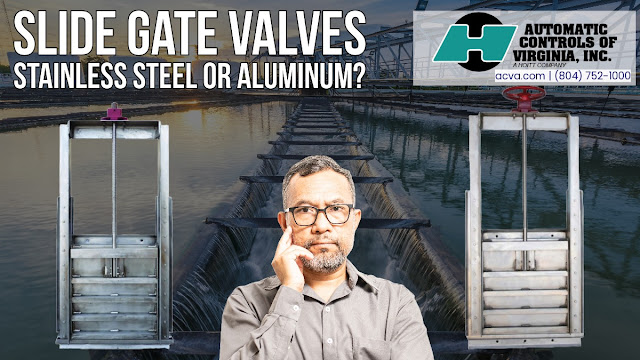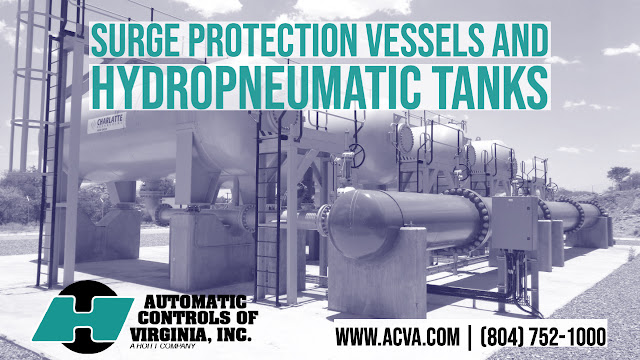An informational blog dedicated to the application of industrial controls, valves and valve automation in the municipal, environmental and industrial markets. This resource will provide educational information in the form of new product introductions, application notes, and basic concepts of all things related to instrumentation, process control, industrial valves, valve actuation, and flow control. Courtesy of Automatic Controls of Virginia (ACVA).
Applications and Advantages of Guided Wave Radar (GWR) Level Transmitters in Modern Industries
- Time Domain Reflectometry (TDR): At the core of GWR is the principle of TDR. An electromagnetic pulse transmits down a probe (guide). When this pulse reaches a medium with a different dielectric constant (like the surface of a liquid), a portion of the signal reflects back to the transmitter.
- Measurement: The time the pulse takes to travel down the probe, reflect from the material's surface, and return is directly proportional to the distance traveled. By knowing the speed of the pulse and the time it took for the reflection to occur, the level of the medium is accurately calculated.
- Probe Types: There are different probe designs available depending on the application. The three most common are:
- Single Rod: Suitable for most applications, especially in smaller tanks or with aggressive media.
- Twin Rod or Coaxial: Ideal for applications with higher demands on accuracy, especially in narrow tanks or with disturbances.
- Cable: Used for tall, narrow tanks.
- Oil & Gas: Measuring levels of crude oil, refined products, or water in storage tanks.
- Chemicals: Monitoring levels of aggressive or caustic substances.
- Pharmaceuticals: Ensuring precise measurements in mixing and storage vessels.
- Food & Beverage: Measuring levels of various food products or ingredients, ensuring hygienic conditions.
- Power Generation: Monitoring levels in coal hoppers or water storage for cooling.
- Water & Wastewater: Tracking levels in storage tanks or sumps.
- Mining: Measuring levels of slurries or solid materials.
- High-temperature and High-pressure: GWR can function in conditions where other level measurement technologies might fail.
- Aggressive Media: Given the suitable probe material, GWR can handle corrosive or aggressive substances.
- Foaming or Agitated Surfaces: GWR provides reliable measurements even in conditions with foam or agitation, which might pose challenges for other technologies.
- Low Dielectric Media: GWR can measure levels of media with low dielectric constants, which some other radar level instruments might struggle with.
- Changing Media Properties: Even if the properties of the medium change (like density or conductivity), GWR measurements remain consistent.
- Safety: For applications where intrusive instruments are not ideal due to safety concerns, GWR offers a non-intrusive option.
Factors to Consider When Choosing Between Aluminum and Stainless Steel Slide Gate Valves for Your Water Facility
- Flow Regulation: The primary purpose of a slide gate valve is to regulate the flow of water. By opening or closing the gate, the operator can control the amount of water that passes through the system.
- Isolation: These valves can act as an isolation mechanism, allowing the shutdown of specific sections of the treatment or distribution system for maintenance, repairs, or emergencies.
- Level Control in Reservoirs and Basins: In water treatment plants, certain processes require maintaining water at specific levels in tanks, basins, or reservoirs. Slide gate valves can control these levels by adjusting the flow in or out.
- Backflow Prevention: In some configurations, slide gate valves prevent backflow, protecting treated water from potential contamination.
Next, let's look into the construction and application differences between aluminum and stainless steel slide gate valves:
Aluminum Slide Gate Valves:
- Lightweight: Aluminum is less dense than stainless steel, making aluminum slide gate valves relatively light, simplifying installation, particularly in scenarios where weight can be a limiting factor.
- Corrosion Resistance: Aluminum forms a protective oxide layer naturally when exposed to air, giving it a degree of corrosion resistance. However, it may be more susceptible to corrosion in specific environments than stainless steel, especially in saline or highly alkaline conditions.
- Cost-Effective: Aluminum slide gate valves are generally less expensive than their stainless steel counterparts.
Stainless Steel Slide Gate Valves:
- Strength: Stainless steel is more robust than aluminum, allowing these valves to handle higher pressures and stresses.
- High Corrosion Resistance: Stainless steel's corrosion resistance is greater than aluminum's, particularly when the material is exposed to aggressive chemicals or saline environments.
- Durability: Due to its strength and resistance to corrosion, stainless steel slide gate valves tend to have a longer service life than aluminum valves, especially in challenging conditions.
- Higher Cost: Stainless steel materials generally cost more than aluminum, leading to a higher price point for these slide gate valves.
Aluminum Slide Gate Valve Application:
- General Water Treatment: Suitable for standard water treatment applications where the water's pH and salinity do not pose significant corrosion risks.
- Distribution Systems: Useful in systems where lightweight components are preferred for ease of installation or maintenance.
- Stormwater Management: Employed in systems that don't expose the valve to particularly aggressive conditions.
Stainless Steel Slide Gate Valve Applications:
- Wastewater Treatment: Particularly effective in wastewater treatment plants where the water might contain a range of chemicals, which can be corrosive.
- Desalination Plants: Given the saline nature of the input water, stainless steel's superior resistance to salt-induced corrosion makes it the material of choice in desalination facilities.
- Chemical Dosing Areas: In sections of water treatment facilities where chemicals are added, stainless steel valves can better resist potential chemical corrosion.
- High-Pressure Scenarios: Due to their strength, stainless steel slide gate valves are suitable for applications requiring the handling of high pressures.
While aluminum and stainless steel slide gate valves have their merits, the choice between them often boils down to the application's specific needs and the environment in which the valve will operate. Careful consideration of factors like corrosion potential, pressure requirements, and budget constraints will help select the most suitable material for a given setting in the water industry. Automatic Controls of Virginia offers expert guidance in selecting the optimal material for your specific valve application. Numerous businesses rely on their proven engineering methodologies and extensive experience in the valve industry, ensuring a technically sound and efficient valve solution for your operational needs.
Automatic Controls of Virginia
https://acva.com
(804) 752-1000
Valve Operators: Worm Gear Actuators, Planetary Gear actuators, and Mechanical Spring Returns
Worm Gear Actuators:
Planetary Gear Actuators:
Mechanical Spring Returns:
Automatic Controls of Virginia: Decades of Trust, Experience, and Expertise in Valve Automation Services
Mechanical Pressure and Temperature Switches: The Vital Role They Play in the Chemical Processing Industry
Safety and process control
Improved efficiency and productivity
Regulatory compliance
Reactor control
Distillation columns
Heat exchangers
Pump and compressor control
Surge Protection Vessels and Hydropneumatic Tanks: Their Use in Water Treatement
Hydropneumatic tanks and surge protection vessels are essential for water supply and treatment systems. They serve different purposes, but both help maintain the efficiency and integrity of water systems.
Hydropneumatic Tanks: Hydropneumatic tanks are used in water supply systems to store and manage pressurized water. They create a pressurized environment to ensure a steady water flow to the end users. These tanks consist of an air-filled space above a water storage area, separated by a flexible diaphragm or bladder.
In the water treatment industry, hydropneumatic tanks provide various services:
- Pressure regulation: Hydropneumatic tanks help maintain consistent water pressure throughout the distribution system, which is essential for adequately functioning treatment equipment and end-user appliances.
- Storage: These tanks store water in a pressurized state, ensuring a continuous water supply during peak demand periods or in case of power outages or pump failures.
- Shock absorption: Hydropneumatic tanks help absorb water hammer or pressure surges, which can occur when pumps start or stop suddenly, preventing damage to the pipeline and other system components.
Surge Protection Vessels: Surge protection vessels, also known as surge tanks or surge arrestors, are designed to protect water supply systems from pressure surges or water hammer. These surges can occur due to sudden changes in flow velocity, such as when a valve is closed, or a pump is started or stopped. Pressure surges can cause damage to pipes, fittings, and other system components, leading to leaks, ruptures, or even system failure.
In the water treatment industry, surge protection vessels:
- Absorb excess pressure: Surge protection vessels have an air cushion or gas-filled bladder that compresses when pressure surges occur, absorbing the extra stress and preventing it from damaging the system.
- Dampen pressure oscillations: These vessels help to dampen pressure oscillations, minimizing the impact of water hammer and reducing the risk of damage to system components.
- Protect equipment: By mitigating the effects of pressure surges, surge protection vessels help extend the life of pumps, valves, pipes, and other equipment in the water treatment system.
Hydropneumatic tanks and surge protection vessels play critical roles in the water treatment industry by ensuring consistent water pressure, storing during peak demand, and protecting system components from damage due to pressure surges and water hammer.
Air and Foot Valves: Ensuring Safe and Efficient Operations in Water and Wastewater Treatment Facilities
Air and Foot Valves are essential in the water and wastewater treatment industry to ensure efficient and reliable flow control in various processes. Both valves serve different purposes and find use in separate parts of the system.
Air Valves:
Air valves play a crucial role in efficiently operating water and wastewater pipelines by managing the air content within the system. They release or admit air from a pipeline under various operating conditions to prevent problems such as airlocks, vacuum formation, and water hammer.
There are three main types of air valves:
a. Air Release Valves: These valves release small pockets of accumulated air from the pipeline when the system operates under pressure, helping maintain the pipeline's efficiency and prevent damage due to air-related issues.
b. Air Vacuum Valves: These valves admit large volumes of air into the pipeline when drained or during a sudden reduction in pressure (e.g., pump shutdown), preventing the formation of a vacuum inside the pipeline, which could cause it to collapse.
c. Combination Air Valves: These valves combine the functions of both air release and air vacuum valves, providing a comprehensive air management solution for the pipeline.
Air valves are common in pipelines for water transmission, distribution, and sewage systems in the water and wastewater treatment industry. They are typically installed at high points along the pipeline or at regular intervals to ensure proper air management.
Foot Valves:
Foot valves are a type of check valve installed at the bottom of a suction pipe or pump intake, primarily in water and wastewater pumping systems. Their primary function is to prevent the backflow of fluid when the pump is not in operation and ensures that the pump remains primed, reducing the need for manual priming and avoiding damage to the pump components.
Foot valves consist of a valve body, a disc or a ball, and a strainer. The disc or ball acts as the sealing element, opening when the pump runs and allowing fluid to flow into the suction pipe. When the pump turns off, the sealing element closes, preventing the fluid from flowing back into the source.
In the water and wastewater treatment industry, foot valves are standard in applications such as raw water intake, pumping stations, and lift stations. They help maintain the efficiency and reliability of the pumping systems, reduce energy consumption, and minimize the risk of pump damage.
Air and foot valves are critical for water and wastewater treatment. Air valves ensure efficient air management in pipelines, while foot valves help maintain the priming of pumps and prevent backflow. Both valves contribute to water and wastewater systems' overall performance, reliability, and safety.
Pneumatic Actuators in Water and Wastewater Treatment
- Control of fluid flow: Pneumatic valve actuators are used to control water and wastewater flow in treatment facilities. They are responsible for opening and closing the valve to regulate the flow rate, ensuring that the right amount of fluid is transported at any given time.
- Regulating pressure: Pneumatic valve actuators control the pressure of process streams in water and wastewater treatment facilities. This is important to maintain a consistent and stable process flow, ensuring that the desired conditions for treatment are maintained.
- Isolation of process streams: Pneumatic valve actuators isolate different process streams in water and wastewater treatment facilities. This helps prevent cross-contamination of other streams, which is critical for maintaining the treated water or wastewater quality.
- Safety control: Pneumatic valve actuators play an essential role in the safety control of water and wastewater treatment facilities. In case of an emergency or a process upset, pneumatic valve actuators can quickly shut down the process stream, reducing the risk of harm to personnel and equipment.
- Process automation: Pneumatic valve actuators can be integrated into the process control system, allowing for automated treatment process control. This reduces the need for manual intervention and increases the efficiency of the treatment process.








